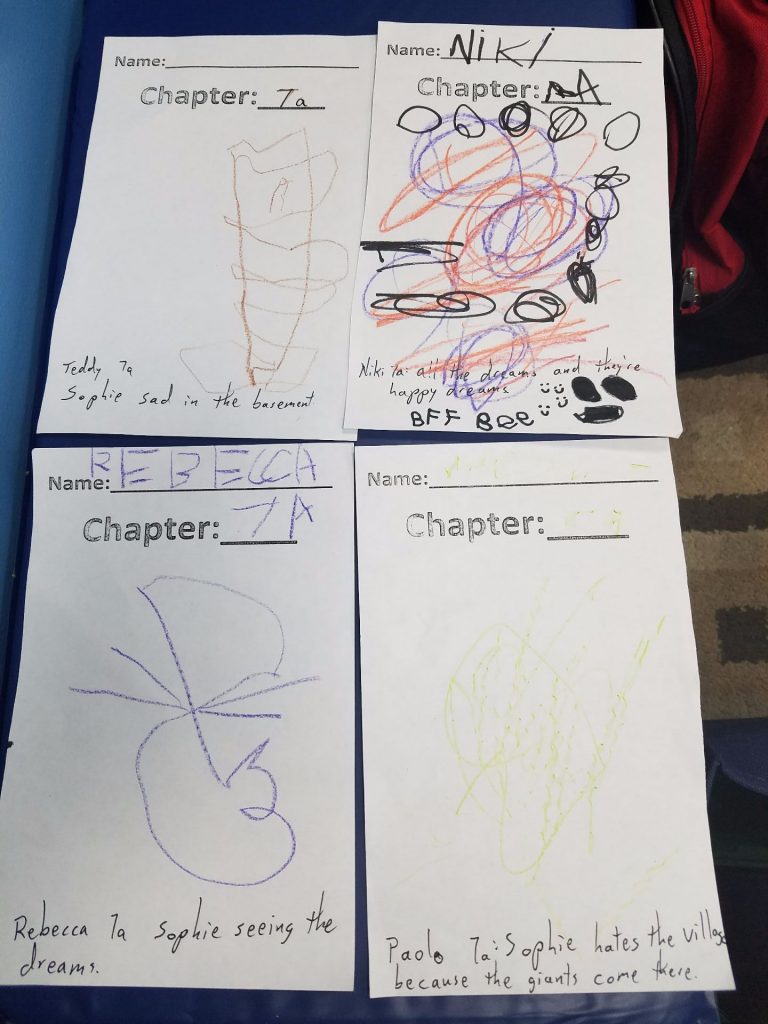We didn’t let the rain get our spirits down, although it did complicate our schedule a little bit. Instead of going to the library today, we used our time to apply what we had already learned to our exploration time. I am thrilled with the response and the ways we demonstrated our learning. Also, at the end of the day, we watched this video to get another perspective on how eyes work; we talked about how we already knew about pupils and irises, and I hinted that we are diving into lenses and retinas tomorrow.
In our read aloud, we heard that the BFG had a lot of jars full of dreams! We didn’t even know you could put dreams in jars. The books described the BFG as ‘marvelous’ and the way Sophie looked at him as ‘suspicious’, and we practiced looking at things in the classroom suspiciously. Yianni predicted that Sophie is still going to get eaten, which made everyone pretty nervous. Anja explained to us that Sophie was sad because she wasn’t able to be with her mom and dad (she’s an orphan). Timo recognized, when we were talking about the word ‘marvelous’, that marvel was something he recognized from the comics. The class’s ability to make predictions, extrapolate and explain character feelings, and recognize parts of words is growing by leaps and bounds! These are important foundational skills for us to develop as beginning readers.
Our sharing time today was a bit trickier, as we were dividing stickers. Since these weren’t as easy to split evenly, more of us got experience dealing with remainders, something guaranteed by sharing 4 stickers with three people. Sokrates explained it wouldn’t be fair if he had 2 and everyone else only had 1, so it was leftover in the bag. Niki made sure everyone in her group understood why they had to leave the extra in the bag. Tove, on the other hand, was quite adamant that what they needed was 2 more stickers, so that everyone in the group could have 2. This got Gia thinking and she realized that if they had 9 stickers in all, then everyone would get 3 stickers. I could not be happier to see the students starting to make the intuitive connection between multiplication and division, as well as seeing how remainders can be useful in fair sharing.
We spent the remainder of our investigation time in pretty open ended investigations to see how they would apply what they knew. Some students were inspired by the bridge work on curriculum night and wanted to revisit bridge building. Anja built a bridge as part of her larger castle, while Teddy realized that 3 blocks on their sides would be the same height as 6 blocks laying flat. We had two teams of people creating their own games. Timo and Sokrates built impressive ramps and assigned points to the different buckets it could land in. Paolo and Jerome decided to build a racetrack for their cars, assigned points based on the distance a car traveled, and tracked the totals to see who would win. We painted with brushes, but they are obviously used to experimenting with their tools now, as Tove decided to use the hard pointy end of the brush to paint as well as the brush end. Similarly, Anja realized that she wanted to paint on the strips we used for the bridges instead of the regular paper. I am honestly inspired by the way they are using the materials at hand in new ways, using their math skills to understand the world around them, and challenging themselves to build bigger and more intricate structures. If you want to create more opportunities for your child to practice this, I heartily recommend finding nonsense games they like and adding mathematical knowledge to them. For example, on the drive home, give 2 points for red cars and 1 point for black cars and see what your total is after the drive. This kind of everyday math exposure is what will give them a deep appreciation for math, not worksheets!
Speaking of mathematical development, I just had to note some great strategic play I noticed in Connect 4 today. Rebecca noticed that her team needed to be careful when the other team got 2 in a row, because that meant they were getting close. There was a disagreement on if the black team had cheated by going too many times, so we realized we could count the pieces that had been played. After that, Paolo was able to explain that he knew it was red’s turn, because there were 2 black pieces played and only 1 red piece (this kind of extrapolation is HUGE as an indicator of mathematical reasoning). Niki worked with her team using the ‘fair share’ language we’ve used with our sharing mats to make sure that each member of her team had the same number of pieces. Timo was sad because, since they decided to play boys v. girls and there were more boys, he explained he wouldn’t have as many pieces as the girls did! Each and every one of these statements are GIANT mathematical concepts that they came to themselves and understood in a fundamental way, simply because they used in a setting they understood and cared about. These activities are not just games for them, they are incredibly intricate and powerful ways for them to learn mathematics!




